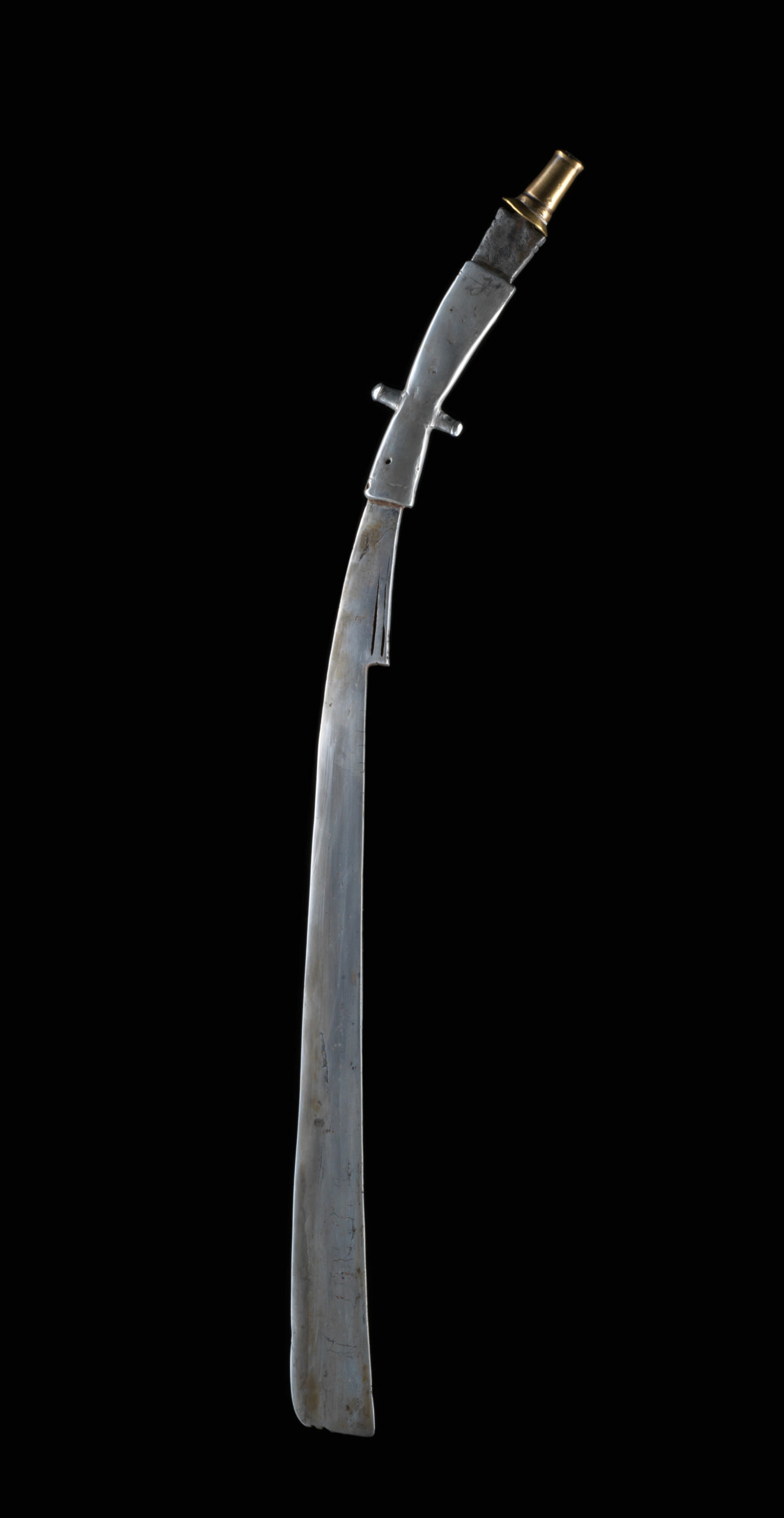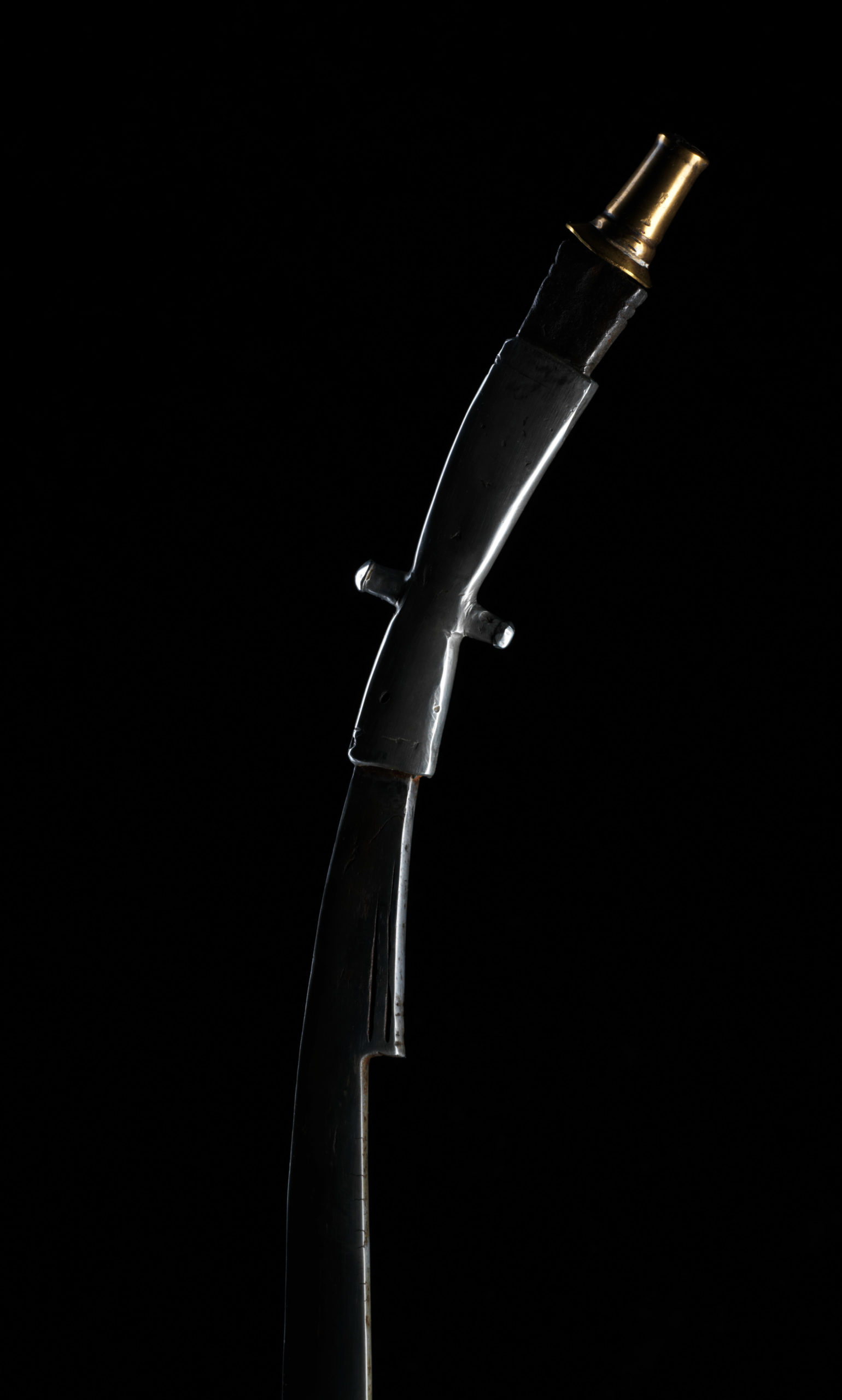Sword “parang pandat”
The object discussed here is a parang pandat or pandit of the Bidayuh-Dayak, formerly known as the “Land-Dayak” (as opposed to the “Sea-Dayak”, the Iban).
The pandat is without question one of the most peculiar sword forms in the world. There seem to be two forms, the pandat of the Si’din Dayak, which are longer and have a forked tip, and the pandit of the Bennah, which correspond to our example. The blade of our piece, as is usual with both forms, merges integrally into the “handle”, if one wants to call the steel handle as such. Bennah-pandat seem to be mostly a little lighter and shorter than the Si’din specimens. The transition to the “handle” is smoother and less abruptly angled. In Bennah-parang, the crosspiece is integrally forged – in contrast to Si’din swords, which have a rod (sekak) inserted through the blade’s neck at this point. As with our pieces, the hilt usually ends in a sharp spine, on which in both types brass caps or ivory elements are attached (in our case brass).
The blade is clearly visible and is made of refined steel. On one side it shows clear traces of hot fracture (which does not impair its usefulness). This is due to elements such as aluminium or phosphorus and/or excessive carbon content in combination with high forging temperature and is common with traditionally produced, i.e. non-industrial, rays. This characteristic is – conditionally – an indication of old age (much more than the often “overrated” rust), as all ethnic groups of Borneo had access to imported steel of high uniformity in the advanced 19th century. The grain is striking and indicates locally melted metal. On the smoother side there is a fine flowing forged texture, which almost looks as intended (in the sense of pamor), but is not, because with blades of this type a conscious pattern control does not play a role.
The handle area is surrounded by a thick tin coating. On Sulawesi (Toraja, Minahasa), the culturally closely related northern part of Borneo, and Timor as well as the central and northern Philippines, tin is a metal with a high symbolic value and is reserved for successful warriors (headhunters). Whether this is due to the importance of tin for the production of tin bronze in the pre-iron age must remain speculative, but can be assumed.
There has been a lot of speculation about the way it was used, but in my opinion this is only of limited help in understanding the significance of this blade form. There is a rumour that the blade could only be used to strike from the bottom up because of its peculiar curvature, or that it was used with both hands, similar to a Japanese sword, in “splitting” strokes from above. Both is impossible, since warriors always use a shield.
The rounded to pointed oval Bidayuh shields utap, which are fundamentally different from the shields of Kajan and Kenyah, can indeed be works of art in their own right and enjoy a high status. The shield was just as indispensable for combat as the sword itself, as throwing spears or even throwing woods were usually used first, which are hardly parable with blades (not to mention blowpipe darts or arrows, which were also common in the past). The small size also makes two-handed handling unlikely.
The Bidayuh, which in the English language literature used to be called Land-Dayak, are still considered to be part of the Dayak group. However, this term (literally from daya, come) is questionable, because there are striking cultural differences, e.g. to the Kayan and Kenyah or to the Malay Iban – both in art, language and social order. The sword type pandat (probably made by pandai, blacksmith or scholar; in the sense of “expert”), which is only known among these ethnic groups, is probably extremely old and dates back to the early Iron Age (or predates the Indian group of forms), because there are striking similarities with an ancient sword type of the Naga in Assam. The swords may have Tibetan origins, just as the Naga language is Tibetan-Malayan. The Bidayuh were partially displaced or mixed with the Iban (hivan, the “wanderers”), who probably came from Sumatra in the first half of the second millennium. This process can again be clearly seen in the blade shapes: the swords parang latok and pandat of the Bidayuh, which are bent at the hilt, are clearly different from the evenly curved Iban blades, which have a distinct Turko-Malayan character and are certainly influenced by Ottoman / Seljuk (14th – 16th century; as jimpul, nyabor / parang nabur). Latok is ultimately a pandat with a Malay handle. Again quite different are the one-sided polished mandau of the East-Dayak (Kayan), which rather remind of Philippine (Visayas) forms.
The main settlement area of the Bidayuh is located on the upper reaches of the Lundu, Sarawak, Sadong and Samarahan rivers. The traditional economy is subsistence farming based on dry rice and hunting. Old sources speak of longhouses, but today almost all traditional longhouses have been replaced by individual houses with streets. An important cultural and architectural feature of the Bidayuh was the chieftain’s house (formerly the skull house), which is now often used as a “national” symbol. This baruk is a round building, which stands on piles about 1.5 metres high. Fruit trees, especially the durian tree, have always been used to mark property. Today, the Bidayuh live in the southwest of the state of Sarawak, which belongs to Malaysia, and the neighbouring Indonesian province of Kalimantan Barat. The majority of the Bidayuh in Sarawak today live in the administrative divisions of Kuching and Samarahan within a radius of about 40 km around the region known as “Greater Kuching”. Today, however, many Bidayuh are based in Kuching, the capital of Sarawak. Most of the Bidayuh settlements are located in the rural areas of Lundu, Bau, Penrissen, Padawan and Serian, where they usually also constitute the largest population group. Three linguistic groups are now identified in Sarawak: Biatah, Bau-Jagoi and Buchar-Sadong. However, differences in vocabulary and emphasis often allow locals to identify the origin of a speaker from a particular village. Since not all dialects are easily understood among themselves, Malay or English is often used as a lingua franca.
| Object | Sword „parang pandat“, „parang pandit“ |
| Culture | Borneo, Nord-Sarawak |
| Time | 18/19th century |
| Dimensions | Length 59 cm |
| Material | Steel, brass |





